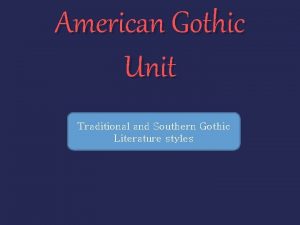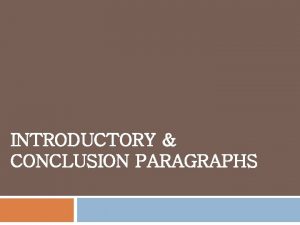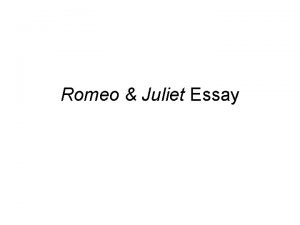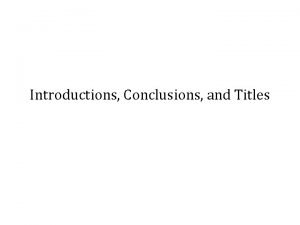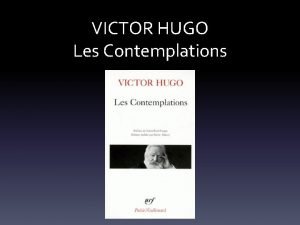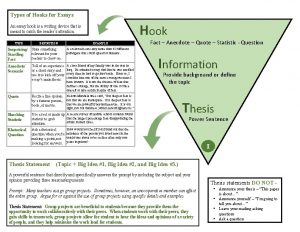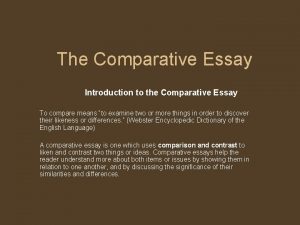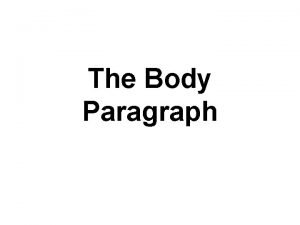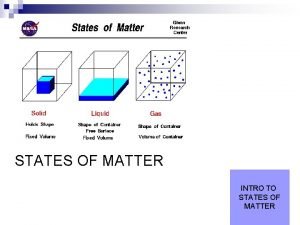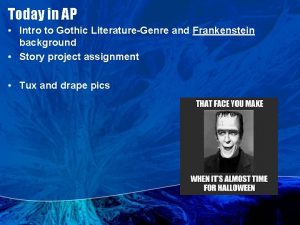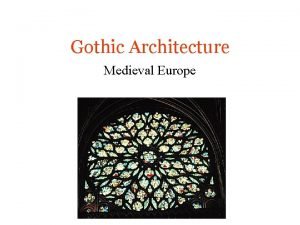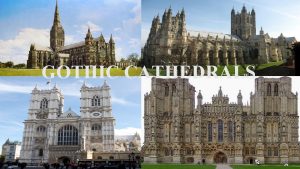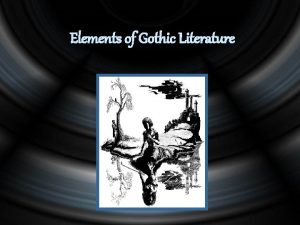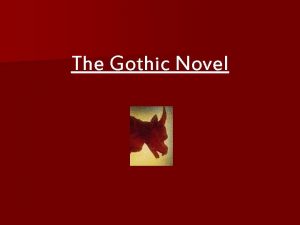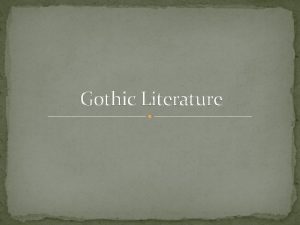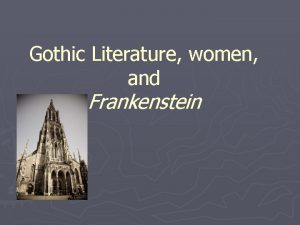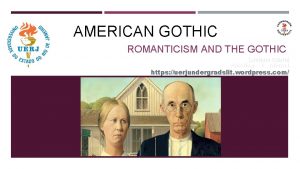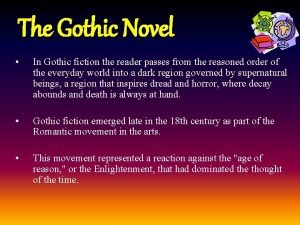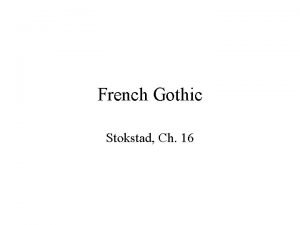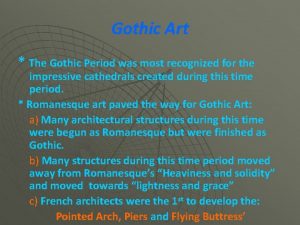Today in AP Intro to Gothic LiteratureGenre and



















- Slides: 19

Today in AP • Intro to Gothic Literature-Genre and Frankenstein background • Story project assignment • Tux and drape pics

Gothic Fiction A presentation on the gothic genre

What is a gothic fiction? • Gothic fiction (sometimes referred to as Gothic horror) is a genre of literature that combines elements of both horror and romance.

Horace Walpole • As a genre, it is generally believed to have been invented by the English author Horace Walple, with his 1764 novel The Castle of Otranto.

Key words: atmosphere and attitude • the literary Gothic embodies an appreciation of the joys of extreme emotion, the thrills of fearfulness and awe inherent in the sublime, and a quest for atmosphere.

• The ruins of gothic buildings gave rise to multiple linked emotions by representing the inevitable decay and collapse of human creations.

Prominent elements • Mystery • The supernatural • Ghosts • Haunted houses • Darkness • Decay

Prominent elements • Death • Madness • Curses • Secrets • Castles • Gothic Architecture

Stock of characters • Tyrants • Villains • Bandits • maniacs • Vampires • Werewolves • Monsters • Demons • Femme fatale • Devil • witch • Byronic Hero

Byronic Hero • The Byronic hero is an idealised but flawed character exemplified in the life and writings of Lord Byron, characterised by his ex-lover Lady Caroline Lamb as being "mad, bad and dangerous to know". The Byronic hero first appears in Byron's semiautobiographical epic narrative poem Childe Harold's Pilgrimage (1812 -18).

Characteristics of a Byronic hero: • High level of intelligence and perception • Cunning and able to adapt • Sophisticated and educated • • Mysterious, magnetic and charismatic Struggling with integrity seductive Social and sexual dominance

Characteristics of a Byronic hero: • Defiant on norms • Cynisism • Dark attributes never present on heroes • Disrespect on rank and privilege • A troubled past • Self destructive behavior; strugles with their integrity.

Byronic vs. Tragic hero • Tragic Hero: – a great or virtuous character in a dramatic tragedy who is destined for downfall, suffering, or defeat Example: Oedipus, the classic tragic hero. • The debate between Victor Frankenstein and Frankenstein's Monster continues…which is which?

The metonymy of gloom and horror.

The metonymy of gloom and horror. • Metonymy is a subtype of metaphor in gothic lit, in which something (like rain) is used to stand for something else (like sorrow). • For example, the film industry likes to use metonymy as a quick shorthand, so we often notice that it is raining in funeral scenes. Lighting crashes, high winds whipping the drapes and putting out candles when we meet the bad guy in their castle. The door slams in a man’s face after a fight with his lady-love and it starts to pour down rain…the environment (atmosphere) reflects the turmoil of the characters.

Examples

We will each write a ghost story, ” Said Lord Byron…” (vii). -Background context for the Shelly’s and Bryon. Preface: Author's introduction v-x. A note about the letters.

Assignment Obj: Write a short ghost story incorporating a tragic or Byronic hero/ine and as much gothic metonymy as you can muster. Requirements: - 1+ typed page - Incorporates a tragic/Byronic hero - Uses elements of gothic metonymy. - It is suspenseful, scary, spooky, etc. - Due Oct. 30/31

Today in Mythology • Turn in all your unit 2 bell ringers
 Best southern gothic novels
Best southern gothic novels For today's meeting
For today's meeting Today's class was amazing
Today's class was amazing Today meeting or today's meeting
Today meeting or today's meeting Characteristic of fingerprint
Characteristic of fingerprint Today's lesson or today lesson
Today's lesson or today lesson Today's lesson or today lesson
Today's lesson or today lesson Introduction paragraph formula
Introduction paragraph formula Romeo juliet opening
Romeo juliet opening Romeo and juliet essay introduction
Romeo and juliet essay introduction Thermochemistry intro and joule conversions
Thermochemistry intro and joule conversions Titles for conclusions
Titles for conclusions Thematic essays
Thematic essays Les contemplations victor hugo introduction
Les contemplations victor hugo introduction Different types of introduction hooks
Different types of introduction hooks What is a paragraph hook
What is a paragraph hook Alternating essay structure
Alternating essay structure Body paragraph format
Body paragraph format Huckleberry finn intro
Huckleberry finn intro States of matter
States of matter
